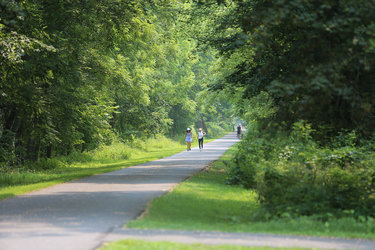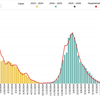Air across NY state is ‘unhealthy for sensitive groups’
ALBANY COUNTY — Canadian wildfires have once again caused an increase in particulate matter in the air across New York state.
“Whether sparked by lightning, intentional land-clearing, or human-caused accidents, wildland fires are burning longer and more often in some areas as the world warms,” says the National Aeronautics and Space Administration Earth Observatory.
The state’s departments of health and environmental conservation put out an advisory on Monday, going from noon till midnight for most of the state, including Albany County, because the air-quality index was over 100. The reading in Albany at 3 p.m. on Monday was 140.
The air quality index was developed as an easy way to correlate levels of different pollutants to one scale, with a higher AQI value indicating a greater health concern.
The state uses six different levels, each mapped with a color, to describe air quality:
— Green is “good” with a 0 to 5 index value, meaning no risks;
— Yellow is “moderate,” 51 to 110, with risks only to people very sensitive to air pollution;
— Orange is “unhealthy for sensitive groups,” 101 to 150;
— Red is “unhealthy,” 151 to 200, during which everyone should reduce long or intense outdoor activities;
— Purple is “very unhealthy,” 201 to 300, during which all outdoor physical activity should be avoided; and
— Maroon is “hazardous,” 301 and higher, during which everyone should remain indoors.
Particulate matter
Exposure to particulate matter can cause short-term health effects, such as irritation to the eyes, nose, and throat, coughing, sneezing, runny nose, and shortness of breath. Exposure to elevated levels of fine particulate matter can also worsen medical conditions such as asthma and heart disease. People with heart or breathing problems, and children and the elderly may be particularly sensitive, the advisory notes.
“With weather patterns anticipated to bring more spikes in smoke in certain regions tomorrow, New York residents and visitors are reminded to include air quality awareness in their daily warm weather routines,” said a Monday press release from the governor’s office.
“Poor air quality can pose serious health risks — especially for those with heart conditions, lung diseases, such as asthma, young children, those over 65 years old and pregnant individuals,” said state Health Commissioner James McDonald in Monday’s release. “To reduce exposure, limit strenuous activity outdoors. We encourage all New Yorkers to visit airnow.gov for the latest air quality forecast and be on the lookout for Air Quality Health Advisories from the Department of Environmental Conservation and the Department of Health.”
At a press conference two years ago as wildfires raged in Québec, McDonald explained that the air-quality index monitors five factors: ozone, particulate matter, carbon monoxide, sulfur dioxide, and nitrogen dioxide.
Particulate matter, he said, is made up of particles smaller than 2.5 microns, noting, for comparison, that human hair has a diameter of about 50 microns.
“You can’t see it with your naked eye,” said McDonald, explaining that the invisible particles “can migrate down your respiratory tract.”
He advised wearing an N95 mask if the air quality index number is over 300. The mask, he said, filters the air you breathe, keeping particles out of your lungs.
Even a surgical mask will provide some protection, McDonald said, if you don’t have access to an N95 mask. “Use what’s the best mask you have available,” he urged.
Ozone
The ozone reading for Albany County on Monday at noon, at 58 on the air-quality index, was “moderate.”
Ozone, the Environmental Protection Agency explains, is a highly reactive gas composed of three oxygen atoms, which is both a natural and a man-made product that occurs in the Earth's upper atmosphere, the stratosphere, and its lower atmosphere, the troposphere.
“Depending on where it is in the atmosphere, ozone affects life on Earth in either good or bad ways,” the EPA says.
Stratospheric ozone is formed naturally through the interaction of solar ultraviolet radiation with molecular oxygen. The “ozone layer,” which is about 6 through 30 miles above the Earth’s surface, reduces the amount of harmful ultraviolet radiation reaching the Earth's surface.
Tropospheric or ground-level ozone — what we breathe — is formed primarily from photochemical reactions between two major classes of air pollutants, volatile organic compounds and nitrogen oxides. Ozone contributes to what we typically experience as smog or haze, and occurs most frequently in the summertime.
The majority of ground-level ozone is the result of reactions of man-made volatile organic compounds from chemical plants, gasoline pumps, oil-based paints, autobody shops, and print shops or reactions from nitrogen oxides from power plants, industrial furnaces and boilers, and motor vehicles.


